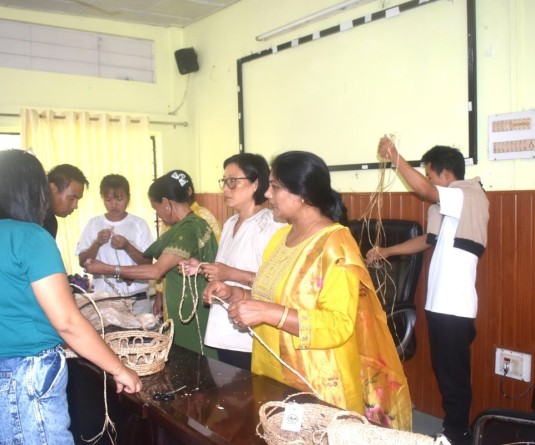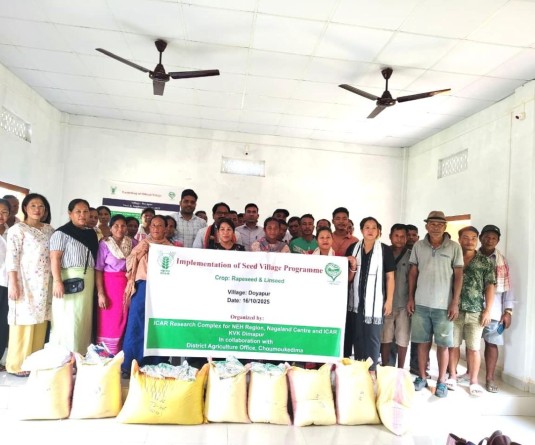
As per India Meteorological Department the district rainfall departure of our region for the month of January, deficient for Mon, normal for Longleng, excess for Mokokchung and Tuensang and large excess for the remaining district.
Total monthly rainfall received as recorded in Meteorological observatory ICAR Nagaland Centre. Medziphema during January month was 34.6 mm. The number of rainy days was 5. Rainfall received was 68% more than the normal.
Keeping in view of threat of COVID-19 spread farmers are advised to follow the government guidelines, personal hygiene, use mask, ensure hand washing with soap at reasonable interval, social distancing during picking of vegetables and other agricultural operation in all crops.
Agronomy –LK Baishya
1. Sowing time of maize in hill districts if sufficient rainfall (pre kharif) is received.
2. Weeding and intercultural operations in vegetables and other standing rabi crops.
3. Time for sowing summer vegetables taking the advantages of pre-monsoon rain.
4. Time for harvesting of ginger and turmeric.
5. Sowing time for millets in hill districts.
Soil Science – Christy BK Sangma and Rokozeno Chalie
1. Nursery for vegetables like tomato, cucumber can be prepared by incorporating FYM or compost.
2. Temperature of soil can also be stabilize by using plastic mulch.
3. While preparing for jhum, bunds or mechanical barriers can be built across the slope to prevent erosion.
4. Mulching can be done for cultivation of any field crop or vegetables in order to conserved moisture.
5. If there is no moisture in the soil, light irrigation can be practiced right after sowing.
Spices, Plantation, Medicinal & Aromatic plants – Azeze Seyie
LITCHI:
1. Spray neem oil (5ml/lit) before flower opening.
2. Keep 10-15 honey bee boxes per ha.
3. Avoid chemical spray during flowering.
Agroforestry – Pempa Lamu Bhutia
Pruning for quality timber production
* Dead, dying and diseased branches can be pruned in any part of the year.
* Late winter is the optimal time to prune most of the forest tree species since the plant is dormant and there is less chance for disease and pest damage. But there may be some exceptions. However, the least desirable pruning time is immediately after new growth develops in the spring and during the active insects or disease months of the tree species.
* Not more than twenty five to thirty percent of the tree canopy should be removed in a year. However, pruning can be done more than the specified percentage if there is a large amount of dead, diseased or dying branches.
* Pruning of branches should be removed only after 3-5 years of planting when you see a flare at the base of the stem near the soil.
* Pruning cuts should be made on the branch just outside the branch collar without tearing off the bark. Branch collar is the swollen region adjoining the tissue between the main stem and the branch.
Poultry – Mahak Singh and Talimoa
1. As very cold weather still prevails over the region, sufficient warmth should be provided to all categories of birds from brooder stage till laying/culling stage.
2. Heat may be supplied at 100 watts per square metre.
3. Cold drafts should be stopped by providing wind protection.
4. Provide sufficient water and feed and deep litter should be warm and dry.
5. Adult/laying birds may suffer from flea infestation so the birds may be dusted with flea powder.
6. Avoid overcrowding of birds which could lead to coccidiosis.
7. In cold winter birds may suffer a host of respiratory ailments therefore farmers should be alert and immediately isolate depressed/immobile/sleepy birds with respiratory symptoms or ruffled feather appearance and precautionary measures may be taken on consultation with a veterinarian.
8. During the shortened daylight period of winter layer birds may show delayed onset of laying cycle despite reaching age of maturity. In such case bright lighting of the layer houses should be done for a minimum of 14 hours per day. A mixture of LED and incandescent bulbs may provide good results.
9. Deworming and vaccination should be done on schedule.
Piggery – Mahak Singh and Talimoa
1. Provision of warmth and comfort is necessary for pigs in winter. For proper bedding hay may be provided or atleast some jute bags provided for warmth.
2. Some sort of curtains may be hung on the open half walls as wind break.
3. Piglets will have to be given warmth through use of various heat sources such as incandescent bulbs or heaters.
4. Piglet diarrhoea in winter exhibit high fatality and will have to be treated with utmost urgency.
5. Vaccination, deworming and hygiene will have to be followed strictly.
6. Serve females in heat in proper timing.
7. Iron feeding of infant piglets is a must.
8. Extra energy components of feed (maize, wheatbran, ricepolish and other cereal grains) may be provided to compensate energy loss for heat generation in cold weather.
Fishery - Jyotish Barman
1. Apply lime after testing the soil and water to maintain optimum pH and as prophylactic treatment.
2. If there is deposition of organic waste in the pond bottom, it has to be removed.
3. Remove aquatic weeds from the pond as well as embankment.
4. Washing of clothes and utensils, bathing of human and animals should be avoided.
5. Discourage entry of birds and animals in to the pond as they may carry germs detrimental to fish.
6. Care should be taken that fish are not injured. If injured, the fish should be dipped in 1 ppm potassium permanganate solution for one minute before releasing into the pond.
7. Diseased or moribund fish should be mixed with lime and buried in a pit at a distance from the pond.
8. If the pond has sufficient water (minimum 1.5m depth), then feeding @ 16kg/ha/day should be continued.
9. If there is algal bloom on the pond surface, suspend feeding and manuring immediately for 15 days.
10. Since, water level usually declines during winter month; fish of bigger size should be harvested to reduce the stocking load.
During forecast of thunderstorm, lightning or hail
Action Suggested:
1. Cover the harvested produce (if in the field) with polythene sheet.
2. In view of thunderstorm accompanied with hail, provide mechanical support to orchards and staking in vegetables.
3. Stay indoors, close windows & doors and avoid travel if possible.
4. Take safe shelters; do not take shelter under trees.
5. Unplug electrical/ electronic appliances. Immediately get out of water bodies. Keep away from all the objects that conduct electricity.
6. Remove dead or rotting trees and branches that could fall and cause injury or damage during a severe thunderstorm.
7. Provide support to banana crops, young fruit plants and cropping up in sugarcane crop/staking of vegetables to prevent the crops from lodging.
8. Keep harvested produces at a safe place.
9. Keep cattle/pigs/goats indoor during a hailstorm.
Issued by ICAR Medziphema






